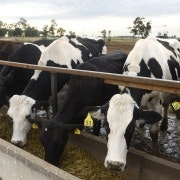Are banks playing it too safe in low gear?
Risk is a relative concept and ANZ Banking Group appears more willing to accept risk than some of its major bank peers.
Despite the finger-pointing from rivals that ensued as a result of ANZ’s exposure to the collapsed Forge Group, ANZ has doubled up on last year’s $1 billion targeted program of lending to small- and medium-sized enterprises, announcing today it was making $2 billion in new lending available to the sector.
Last year, ANZ and Commonwealth Bank were the two major banks to grow their share of business lending above system growth, which has been weak. National Australia Bank and Westpac appeared willing to accept some loss of share to focus on credit quality.
Despite the Forge experience, which ANZ has said won’t have a material impact on its loan losses, ANZ last month forecast the total charge for bad and doubtful debts for the 2013-14 financial year would be 10 per cent lower than last financial year’s. In the December quarter, the charge of $191 million compared with losses of $311 million in the same quarter of the 2012-13 year.
All the majors are experiencing a level of bad and doubtful debt charges that is historically low, which may be a consequence of the relative low levels of new lending.
That’s partly a function of their own risk aversion and focus on balance sheet strength in the wake of the financial crisis but it also reflects the risk-aversion of businesses large and small over that period.
The majors have offset the lack of volume growth and the squeeze on their net-interest margins from higher funding costs and the competition for the business that is available (which has focused on home loans) mainly by large-scale cost-cutting.
ANZ, however, grew its domestic commercial and corporate lending by seven per cent last financial year and added a net 30,000 new customers in those segments. It has been growing its presence in those segments at rates above the system’s for the past 18 months or so. It grew its share of lending and deposits in those segments by more than 16 per cent last financial year - nearly twice the rate of system growth.
While National Australia Bank (which last month accused ‘’some competitors’’ of weakening their credit standards) is the major with the biggest business franchise, ANZ has historically had a disproportionate share of SME lending and it appears it wants to strengthen that position. It also had above-system growth in home loans and retail deposits, albeit that the rate of growth wasn’t as marked.
The grab for increased market share may relate to the pressure ANZ came under last year to devote capital and focus to its domestic franchises rather than continue to invest in its ‘’super-regional’’ strategy in Asia. ANZ’s Mike Smith has accused critics of the strategy of not understanding its detail and long-term potential, and of under-estimating the benefits to ANZ’s transactional businesses of its network in the region.
In any event, ANZ demonstrated last year that it can both pursue the super-regional strategy (albeit at a slightly more measured pace) while also actively seeking to grow its domestic market shares.
While demand for business credit does remain weak and the outlook for demand uncertain, there is an argument that the banks as a group aren’t taking sufficient risk for the good of the economy.
The banks are quite rightly concerned not to take on new bad and doubtful debts in an environment where the resources sector and those that service it are coming under pressure as the investment boom disappears, and where the overall economy appears to be softening and job losses mounting.
With the majors’ charges against profits for bad-and-doubtful debts dropping below 20 basis points as a percentage of their loan portfolios, however, their charges are about half what used to be regarded as normal within a healthy economy.
Whether that’s because they aren’t taking enough risk and properly discharging their roles as financial intermediaries or because their customers are themselves so risk averse there isn’t any meaningful demand for business credit isn’t clear – although the growth that ANZ and CBA achieved last year would tend to suggest there is some demand when the supply is there.
It may have been a coincidence but HSBC today revealed it plan to target SMEs with $250 million of lending while Bank of Queensland said it was growing its business lending at about twice the system’s growth rate.
Whether it’s a good thing that a number of banks are targeting the same sector or not won’t be clear until there is the benefit of hindsight.
If they maintain control of credit quality and/or the broader economy remains relatively stable, they’ll achieve higher levels of growth than their peers; if they don’t, they’ll end up with higher levels of bad debts.
















